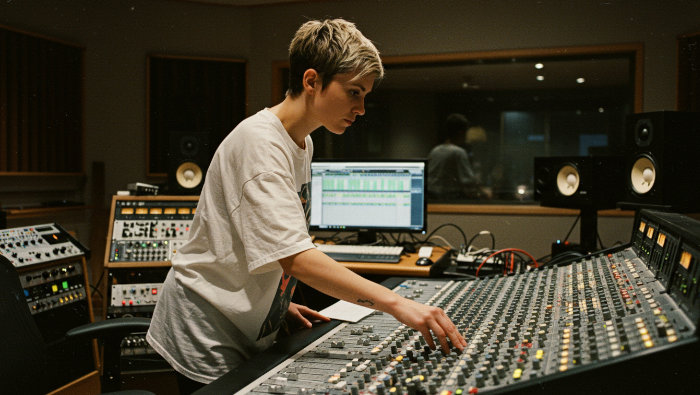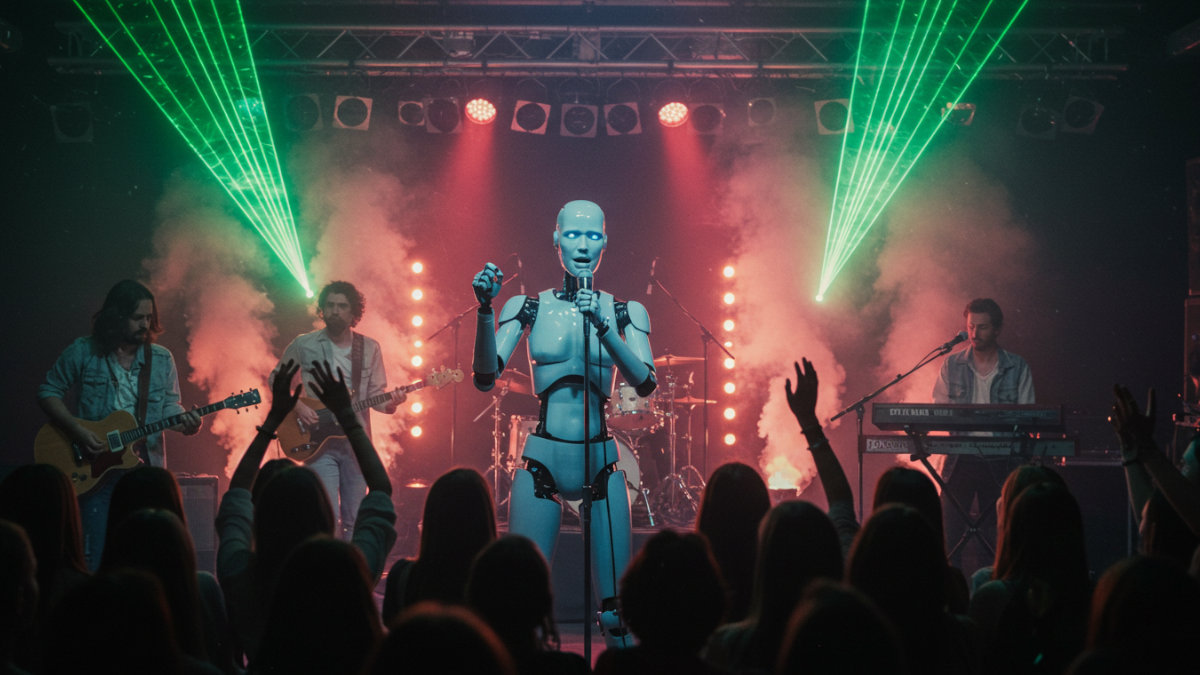HSS Podcast - Vocal Removal by AI - Magic Remixes?
HSS Staff
Hey music lovers! Ever dreamt of taking your favorite song and twisting it into your own unique remix? Well, the dream is closer than ever thanks to AI vocal removal tools! But before you dive headfirst into creating the next big dance anthem, let’s talk about whether these tools are actually good enough.
In this post, we’re going to dissect the world of AI vocal removal and see if it lives up to the hype. We’ll be covering:
- Current AI Vocal Removal Accuracy: How well do these tools really strip out the vocals? Are we talking pristine instrumentals or a muddy mess?
- Artifacting and Audio Quality Issues: What are the common sonic hiccups you might encounter, and how can you minimize them?
- Suitability for Different Genres: Does AI vocal removal work equally well on a delicate acoustic ballad and a heavy metal banger? We’ll explore the genre limitations.
- Impact on Remixing Creativity: Are these tools empowering remixers, or are they leading to a wave of generic, AI-dependent creations?
- Legal and Ethical Considerations: Can you just rip the vocals from any song and remix it? We’ll touch on the legal gray areas and ethical dilemmas.
So grab your headphones, fire up your DAW, and let’s dive in!
Current AI Vocal Removal Accuracy
Assessing the current accuracy of AI vocal removal tools requires acknowledging the constant advancements in machine learning. Accuracy isn’t a fixed number but rather a spectrum, heavily influenced by the input audio. Generally, recent advancements have yielded notable improvements, but limitations persist.
For pop music, where vocals are often mixed prominently and the instrumentation is relatively clean, current AI can achieve a separation accuracy that is usable, producing instrumentals suitable for basic remixes or mashups. Expect some vocal bleed and potential alteration of instruments sharing the vocal frequencies, such as guitars or keyboards. A practical tip here is to isolate the entire vocal range during editing, and then apply gentle noise reduction specifically to those problem areas.
Electronic music often fares better because it relies on synthesized sounds which the AI more easily distinguishes from vocals. However, complex EDM tracks with heavy layering can still present challenges. Conversely, simpler electronic tracks with distinct vocal and instrumental components frequently yield impressive results. Remember to audition your results at different volumes; faint artifacts are easier to hear at higher volumes.
More challenging genres include rock, metal, and acoustic recordings. These typically involve instruments covering a wider frequency range and often feature more bleed between tracks during the recording process. In these cases, the instrumental track will likely suffer from noticeable artifacts, missing frequencies, or altered instrument sounds. With rock and metal, there will invariably be some frequency interference, meaning the instrumental will sound thinner than ideal. Consider re-amping key instruments where possible or synthesizing similar sounds.
It’s essential to understand that AI “accuracy” is relative. It doesn’t mean perfect isolation; it means a usable output that can be further refined. Factors such as the bit rate and file format also influence the results. Higher quality audio will always produce better separation. Be critical, listen closely, and don’t hesitate to combine AI-generated elements with other sources to create the best possible remix.
Artifacting and Audio Quality Issues

A primary concern when using AI vocal removal tools is the introduction of artifacts and degradation of overall audio quality. These imperfections manifest in various ways, directly impacting the suitability of the extracted instrumental for professional use. Understanding the common types of artifacts and how to mitigate them is crucial for achieving acceptable results.
One prevalent issue is “spectral masking artifacts,” often sounding like faint swirling or phasing effects. These arise because AI algorithms work by separating frequency bands, sometimes imperfectly reconstructing the audio. Areas where the vocal and instrumental frequencies overlap significantly are particularly susceptible. Applying a subtle de-esser after vocal removal can sometimes alleviate these artifacts, focusing on the specific frequency ranges where the swirling is most pronounced.
Another common problem is “gating,” where instruments sharing frequencies with the vocals get abruptly cut off or attenuated. This effect is most noticeable on instruments with sustained notes or long decays, such as pads, strings, or guitars. Examine the frequency balance in the instrumental track. If you have a track with gating issues, sometimes a very short, gentle reverb can smooth over the abrupt silences.
Furthermore, the overall audio quality often suffers from a loss of fidelity. The extracted instrumental might sound thinner, less dynamic, or lacking in low-end punch. This happens because the AI process isn’t lossless; it discards information to isolate the vocal. Try layering the AI-generated instrumental with a clean sample of the original track’s bass frequencies to restore some of the low-end.
Beyond these specific artifacts, general noise and hiss can also be amplified during the separation process. Employing noise reduction plugins cautiously can help minimize these issues, but be mindful of over-processing, which can further degrade the audio. It’s a delicate balance between removing unwanted noise and preserving the integrity of the instrumental. Ultimately, managing artifacts requires a combination of careful listening, targeted processing, and a willingness to experiment with different AI tools and techniques.
Suitability for Different Genres
The effectiveness of AI vocal removal varies significantly across different musical genres due to variations in instrumentation, mixing techniques, and vocal prominence. Understanding these genre-specific nuances is crucial for setting realistic expectations and optimizing results.
Pop Music: Generally, AI performs reasonably well with modern pop songs. The vocals are often mixed prominently and cleanly, making them easier to isolate. Expect some minor bleed and potential alterations to instruments in the vocal range, like synths or guitars. Tip: Experiment with different AI models, as some are better at isolating female vocals versus male vocals in this genre.
Electronic Dance Music (EDM): EDM often presents a favorable scenario for AI vocal removal. Synthesized sounds tend to be more easily differentiated from vocals. Tracks with clear, distinct vocals and well-separated instrumentals yield the best results. However, complex EDM tracks with heavy layering and distortion can pose challenges. If creating a remix, consider recreating some instrumental parts to maintain a professional sound.
Rock and Metal: These genres often present the biggest hurdles. Guitars and vocals frequently occupy similar frequency ranges, leading to significant interference during the separation process. The resulting instrumental track can sound thin, lifeless, and riddled with artifacts. While AI can still be used, extensive post-processing and manual editing will likely be required. Often, the extracted vocals are also distorted. Consider using them creatively for sound design.
Hip-Hop: The results with hip-hop vary depending on the track. Samples and clean vocals can be separated well. However, heavily processed vocals (e.g., autotune, distortion) and complex arrangements may prove difficult. A tip here is to focus on remixing the instrumental and creating a new vocal line, rather than relying on separating the original vocal.
Acoustic and Folk: Sparse arrangements with a prominent vocal and acoustic instruments can yield acceptable results, though the AI might struggle with subtle nuances and harmonics. Fingerpicked guitars, in particular, can be difficult to separate cleanly from vocals. If you are using AI on folk songs, check the low frequencies for muddiness.
In conclusion, genre plays a critical role in the success of AI vocal removal. Experimentation and careful evaluation are essential for determining the suitability of AI-generated instrumentals for remixing purposes.
Impact on Remixing Creativity

AI vocal removal tools have undeniably altered the landscape of remixing, presenting both opportunities and challenges for creativity. While they lower the barrier to entry, allowing more aspiring producers to engage in remixing, they also necessitate a shift in creative approach.
On one hand, AI empowers remixers by providing access to instrumentals that were previously unavailable or difficult to obtain. This unlocks a vast catalog of potential source material, inspiring remixes of tracks that might otherwise remain untouched. For example, a producer can quickly extract a usable (albeit imperfect) instrumental of an obscure indie song and reimagine it within a completely different genre, fostering cross-genre experimentation. The speed at which this process can now be done frees up creative time for experimenting with the new elements in the remix.
However, the inherent imperfections of AI-generated instrumentals force remixers to adopt a more resourceful and imaginative approach. The artifacts and audio quality issues necessitate creative solutions like layering, sampling, and sound design to fill in gaps and enhance the overall sonic texture. This can lead to unexpected and innovative sonic landscapes that might not have emerged otherwise. For example, a distorted AI vocal removal vocal track can be heavily processed and used as a textural element.
Furthermore, AI can encourage remixers to focus more on arrangement and structural creativity. Instead of relying solely on a pristine instrumental, producers can explore new arrangements, add unique sonic elements, or re-contextualize the original vocals in unexpected ways.
Despite these creative advantages, over-reliance on AI can also stifle originality. If remixers simply accept the AI-generated instrumental without critical evaluation and creative manipulation, the resulting remixes can lack personality and character. Therefore, it’s crucial to view AI as a tool to augment, rather than replace, human creativity. The best remixes leverage AI’s capabilities while retaining the remixer’s unique artistic vision.
Legal and Ethical Considerations
The ease of vocal removal provided by AI tools brings significant legal and ethical considerations for remixers. While technically feasible to create instrumentals and remixes, it’s crucial to understand and respect copyright laws and artist rights.
Copyright law protects both the musical composition (melody, harmony, lyrics) and the sound recording (the specific recording of the song). Creating a remix using an AI-generated instrumental still constitutes creating a derivative work, meaning you are building upon copyrighted material. Without proper permissions, distributing or commercially exploiting such remixes is a copyright infringement. Even if the AI renders an “imperfect” instrumental, the core copyrighted work is still present.
Ethically, artists have the right to control how their work is used and reinterpreted. Remixing a song without permission disrespects their artistic vision and potentially undermines their commercial interests. Obtaining licenses or permission from copyright holders (usually the publisher for the composition and the record label for the sound recording) is essential. Services like Harry Fox Agency and mechanical licensing collectives can facilitate this process, though acquiring rights to use both the composition and sound recording can be complex and expensive.
It’s tempting to argue “fair use,” a legal doctrine that allows limited use of copyrighted material without permission for purposes like criticism, commentary, news reporting, teaching, scholarship, or research. However, using AI-generated instrumentals for commercial gain, even with significant alteration, is unlikely to fall under fair use. Creating remixes solely for non-commercial, personal enjoyment might be a gray area, but sharing them publicly, even for free, could still be considered infringement.
Before releasing a remix, actively seek permission. Explore platforms like SoundCloud and YouTube, which often have copyright management systems in place that can help you identify and potentially monetize remixes legally. Consider contacting the artist directly; smaller artists might be more open to granting permission than large corporations. Remember, respecting artists’ rights and adhering to copyright laws is essential for maintaining a sustainable and ethical remixing practice. Ignoring these considerations could lead to legal action and damage your reputation.
In conclusion, AI vocal removal tools offer a tantalizing glimpse into the future of remixing, providing unprecedented access to instrumentals. However, they are not a magic bullet. Imperfections in audio quality and the need for creative problem-solving remain significant challenges. While suitability varies by genre, and legal and ethical considerations must always be paramount, AI empowers remixers with new possibilities. So, experiment, create, and remember to always respect the original artists. What remixes will you create with these evolving tools?

